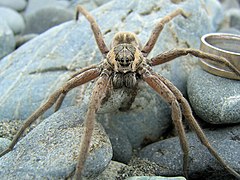Dolomedes aquaticus
| Dolomedes aquaticus | |
|---|---|
 |
|
| Female with egg sac | |
| Scientific classification | |
| Kingdom: | Animalia |
| Phylum: | Arthropoda |
| Class: | Arachnida |
| Order: | Araneae |
| Family: | Pisauridae |
| Genus: | Dolomedes |
| Species: | D. aquaticus |
| Binomial name | |
|
Dolomedes aquaticus |
|
Dolomedes aquaticus is a fishing spider that lives and hunts along the gravel banks of unforested New Zealand rivers. It prefers open riverbanks where it lives under rocks, usually less than 5 metres from the river. Its colouring allows it to blend in with river stones. Normally nocturnal, it sits and waits for its prey after dark, and can survive for short periods under the water.
The total length of this spider is 18 mm. The cephalothorax is 8mm long and is chocolate brown, with a supra-marginal band of yellow extending from the posterior slope to the anterior angle of the pars cephalica: falces, maxillæ, labium, and sternum chocolate-brown; legs and palpi, brown; abdomen above greenish-brown with two longitudinal rows of brown-margined yellow spots, at the sides greyish, and below dusky-brown with four more or less continuous longitudinal whitish stripes converging towards the anus. At the base of the dorsal surface there is a short median spathulate band of paler hue than the rest of that surface, and on each side of this band a short grey fleck. The cephalothorax and abdomen are densely covered with grey, yellow, and brown pubescence.
Dolomedes aquaticus is found on plants, stones, or pieces of wood at or near the surface of the water. It can swim and run very rapidly on the surface of the water. When teased it makes for the nearest object, down which it runs to the bottom of the water, where it remains till all danger has gone. While incubating, the female goes some distance from the water, and lives under a large stone or a piece of wood. Here she remains till the young are hatched. During incubation she shows considerable aversion to water. The cocoon is globular, and is carried under the sternum, to which it is firmly held by the palpi and strands of web from the spinners.
...
Wikipedia
